
Bushrangers were originally escaped convicts in the early years of the British settlement of Australia who used the bush as a refuge to hide from the authorities. By the 1820s, the term had evolved to refer to those who took up "robbery under arms" as a way of life, using the bush as their base.

Australian art is any art made in or about Australia, or by Australians overseas, from prehistoric times to the present. This includes Aboriginal, Colonial, Landscape, Atelier, early-twentieth-century painters, print makers, photographers, and sculptors influenced by European modernism, Contemporary art. The visual arts have a long history in Australia, with evidence of Aboriginal art dating back at least 30,000 years. Australia has produced many notable artists of both Western and Indigenous Australian schools, including the late-19th-century Heidelberg School plein air painters, the Antipodeans, the Central Australian Hermannsburg School watercolourists, the Western Desert Art Movement and coeval examples of well-known High modernism and Postmodern art.
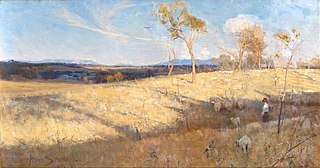
The Heidelberg School was an Australian art movement of the late 19th century. It has been described as Australian impressionism.

Frederick Wordsworth Ward, better known by the self-styled pseudonym of Captain Thunderbolt, was an Australian bushranger renowned for escaping from Cockatoo Island, and also for his reputation as the "gentleman bushranger" and his lengthy survival, being the longest-roaming bushranger in Australian history.
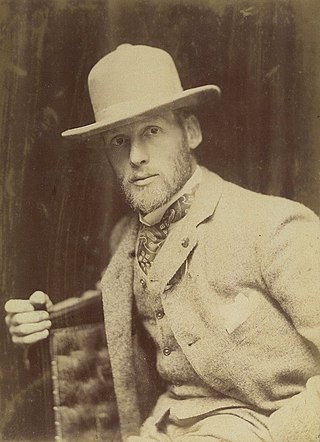
Thomas William Roberts was an English-born Australian artist and a key member of the Heidelberg School art movement, also known as Australian impressionism.
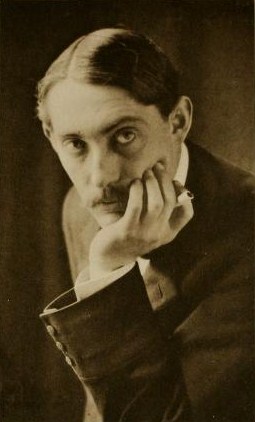
Charles Edward Conder was an English-born painter, lithographer and designer. He emigrated to Australia and was a key figure in the Heidelberg School, arguably the beginning of a distinctively Australian tradition in Western art.

Sir Arthur Ernest Streeton was an Australian landscape painter and a leading member of the Heidelberg School, also known as Australian Impressionism.
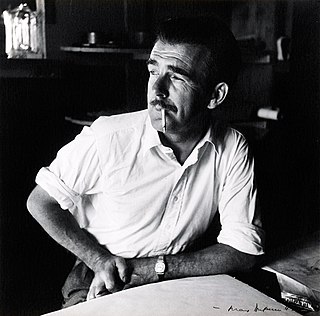
Sir William Dobell was an Australian portrait and landscape artist of the 20th century. Dobell won the Archibald Prize, Australia's premier award for portrait artists on three occasions. The Dobell Prize is named in his honour.
James Hume Nisbet was a Scottish-born novelist and artist. Many of his thrillers are set in Australia.

Shearing the Rams is an 1890 painting by Australian artist Tom Roberts. It depicts sheep shearers plying their trade in a timber shearing shed. Distinctly Australian in character, the painting is a celebration of pastoral life and work, especially "strong, masculine labour", and recognises the role that the wool industry played in the development of the country.

The 9 by 5 Impression Exhibition was an art exhibition in Melbourne, Australia. It opened on 17 August 1889 at Buxton's Rooms on Swanston Street and featured 183 works, the majority of which were painted by Charles Conder, Tom Roberts and Arthur Streeton of the Heidelberg School art movement, also known as Australian impressionism. The exhibition's name references the dimensions of most of the paintings—9 by 5 inches, the size of the cigar box lids upon which many of the works were painted—as well as the impressionist techniques employed by the artists.

The Golden Fleece, originally known as Shearing at Newstead, is an 1894 painting by the Australian artist Tom Roberts. The painting depicts sheep shearers plying their trade in a timber shearing shed at Newstead North, a sheep station near Inverell on the Northern Tablelands of New South Wales. The same shed is depicted in another of Roberts' works, Shearing Shed, Newstead (1894).
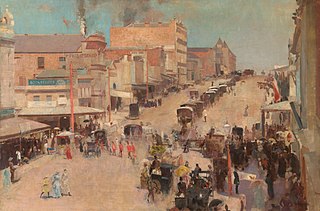
Bourke Street is a 1886 painting by Australian artist Tom Roberts. Roberts originally titled the work Allegro con brio. The painting depicts the western end of Bourke Street, one of the main thoroughfares in Melbourne as seen from the Buckley & Nunn drapery.

A break away! is an 1891 painting by Australian artist Tom Roberts.

Footballer is a 1946 painting by Australian artist Sidney Nolan. It depicts an Australian rules footballer standing before a crowd of spectators at a football match. For many years the painting was thought to be a generic image of a footballer, however Nolan later revealed that the painting is based on Bill Mohr, a star player for the St Kilda Football Club during the 1930s.

James Ranalph Jackson (1882-1975) was an Australian painter, perhaps best known for painting views of Sydney harbour. Today, his work hangs in public galleries in both Australia and New Zealand. The Art Gallery of New South Wales has 16 of his paintings, however none are currently on display.

Sir Sidney Robert Nolan was one of Australia's leading artists of the 20th century. Working in a wide variety of media, his oeuvre is among the most diverse and prolific in all of modern art. He is best known for his series of paintings on legends from Australian history, most famously Ned Kelly, the bushranger and outlaw. Nolan's stylised depiction of Kelly's armour has become an icon of Australian art.

In a corner on the Macintyre (Thunderbolt in an encounter with police at Paradise Creek) is a 1895 painting by the Australian artist Tom Roberts. The painting is thought to depict the bushranger Captain Thunderbolt in a shootout with police.

Florence Ada Fuller was a South African-born Australian artist. Originally from Port Elizabeth, Fuller migrated as a child to Melbourne with her family. There she trained with her uncle Robert Hawker Dowling and teacher Jane Sutherland and took classes at the National Gallery of Victoria Art School, becoming a professional artist in the late 1880s. In 1892 she left Australia, travelling first to South Africa, where she met and painted for Cecil Rhodes, and then on to Europe. She lived and studied there for the subsequent decade, except for a return to South Africa in 1899 to paint a portrait of Rhodes. Between 1895 and 1904 her works were exhibited at the Paris Salon and London's Royal Academy.

The New House is a 1953 painting by Australian artist John Brack. The painting depicts a man and a woman standing in front of their fireplace in a room.




















